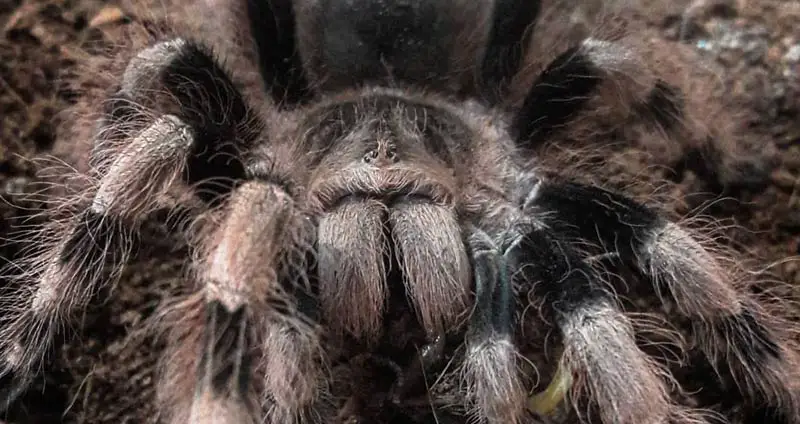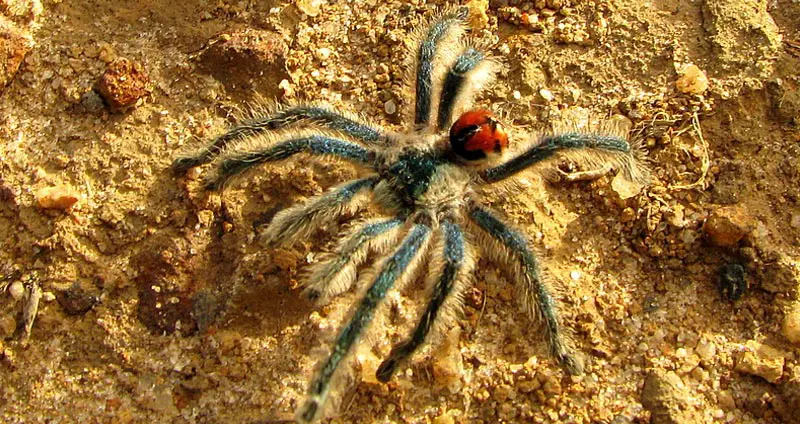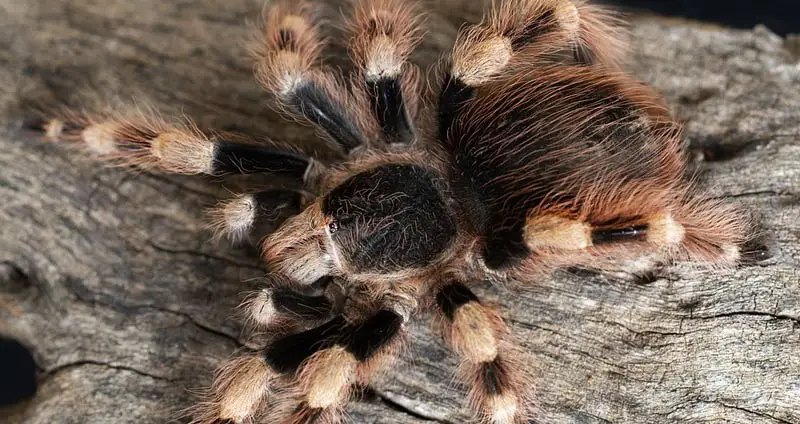Native to Brazil, this visually stunning tarantula species might seem like a nervous, anxious species, but that shouldn’t deter you from potentially owning one!
It’s one of the less common tarantulas in the pet trade, which makes it all the more special. Nhandu coloratovillosus is a rare, but precious, sight in captivity.
This care sheet covers all the important things that you need to know about this species, including its temperament, diet, and enclosure requirements.
Table of Contents
Nhandu coloratovillosus Care Sheet
| | |
Common Name |
Brazilian Black & White |
Species Type |
New world terrestrial |
Natural Habitat |
Found in Brazil and Paraguay in areas with decent humidity and tree coverage. |
Growth Rate |
Medium-to-fast growth rate, growing an inch or two per year. |
Adult Size |
Females reach a legspan of about 6.5″, with males typically measuring slightly smaller. |
Lifespan |
Females are expected to live up to 15 years, while males only live up to about 4 years. |
Enclosure |
The enclosure should be wider than it is tall with an emphasis on floor space. 6 inches of substrate should line the floor of the enclosure, and a hide and water dish need to be present. |
Temp/Humidity |
75°F to 80°F with about 70% to 80% humidity. |
Diet |
A great eater that can eat an adult cricket every day. Can also eat mealworms and dubia roaches. |
Temperament |
Behavior varies greately between specimens. Some are extremely docile, while others are nervous and skittish. |
Experience Level |
Beginner – Very easy to care for in terms of enclosure and diet. Can be very skittish, but that’s nothing that’s hard to deal with. |
Average Cost |
Slings ~ $30, Males ~ $75, Females ~ $150+ |
Nhandu coloratovillosus Appearance
The larger Nhandu coloratovillosus has a brilliant distinctive appearance. Its legs have a span of about 6.5″ when they’re fully-grown, and they’re distinguished by three broad white stripes that shrink in size as you go down the leg.
Under certain lighting, their beautiful light-colored accents can sometimes appear honey-colored or off-white.
The prosoma of the Nhandu coloratovillosus is marked by a black color that gives way to a stark white, similar to that of its legs.
The abdomen is noted for its burnt beige hairs. Mingling with a velvet black coat, that hair can often assume a dark orange appearance. This can make its luscious coat sometimes appear a rich, dark brown.


via @tikkit72 / Instagram
Nhandu coloratovillosus Temperament
Although this is a bold tarantula, it’s not one that’s aggressive. However, that doesn’t mean that it hesitates to flick its urticating hairs when it feels threatened.
The temperament could differ from one Brazilian White and Black to another, though. After all, tarantulas are individuals. Each one has a unique personality of its own.
One Nhandu coloratovillosus could be a feisty creature, while another could be somewhat mellow and agreeable. Overall, juvenile females are known to be more high-strung. They easily feel threatened and are extremely sensitive to sudden changes.
With this species particularly, slings are decently skittish and nervous, but don’t really show signs of aggression beyond that.
Usually, a Nhandu coloratovillosus varies from skittish to defensive. But when confronted, it would rather just wisely retreat than hold its ground and fight.
This makes handling a challenge. In fact, even though it’s a new world tarantula, you should consider the Nhandu coloratovillosus a hands-off species.
As handsome as they look, handling those tarantulas is heavily advised against. Easily nervous, they despise disturbances and like to be left in peace most of the time.
Housing Nhandu coloratovillosus
Like all tarantulas, a Brazilian White and Black needs a secure and safe enclosure. This is important for its temperament and general welfare.
Overall, though, supplying your N. coloratovillosus is a suitable enclosure is surprisingly simple to do if you just take a few things into consideration.
Optimal Nhandu coloratovillosus Enclosure
This is a terrestrial tarantula species, so your focus should be on providing it with plenty of floor space and depth for burrowing. A basic terrestrial tarantula enclosure setup is perfect for this species.
I would recommend one of the following two enclosures: the Exo Terra 18″ × 18″ × 12″ terrarium or the Repti Zoo 20″ x 12″ x 10″ enclosure. Both of these are more than suitable for this active and skittish tarantula species.
Specifically, these two enclosures have plenty of space, visibility, accessibility, and ventilation to keep your Nhandu coloratovillosus happy and healthy.
Enclosure Decorations
There are a few supplies that you’ll need to have in order to make the enclosure suitable for Nhandu coloratovillosus.
First and foremost, as this is a burrowing terrestrial species, you need to layer the base of the enclosure with about 6 inches of moisture-retaining substrate. Not only will this allow for burrowing, but it will also work to maintain a constant humidity level.
Additionally, a tarantula hide should be provided so that your N. coloratovillosus can take shelter in it as needed. As this is a more skittish species, it’s essential that they have a place to hide out in and de-stress.
Finally, a you should provide a clean and full water dish at all times. This works to prevent dehydration in addition to contributing to the enclosure’s humidity.
Enclosure Humidity/Heating
Nhandu coloratovillosus is a tropical species. In its native Northern Brazil, temperature averages about 77°F.
Accordingly, you should offer your tarantula something between 75°F and 80°F for their enclosure. This is room temperature for most people, so supplemental heating is almost never necessary.
However, if you do find that your house frequently drops well below this range, you may want to provide supplemental heating through the use of a space heater.
Humidity should ideally be kept at 70-80%. This is decently high, but can be obtained through the presence of a water dish and the constant misting of the substrate. Don’t let the enclosure get too wet and swampy, though!
It’s recommended that you utilize a temperature/humidity monitoring tool so that you can make adjustments as soon as they’re needed.
Diet
An adult Nhandu coloratovillosus needs about an adult cricket every day. This can be supplemented with dubia roaches, mealworms, or the occasional pinkie mouse.
For your N. coloratovillosus spiderlings, flightless fruit flies are ideal. Keep feeding your spiderlings fruit flies until they reach ½”, and then introduce them to pinhead crickets.
When they’re grown, avoid giving them large food items. Always pick something smaller than the tarantula itself to avoid potential harm.
This is a great eater, and will gladly put on a show for you when you drop an insect into their enclosure. Don’t worry about overfeeding them, but be sure to remove any uneaten food after feeding is done.
Health Concerns
Captive-held pet tarantulas almost never experience any health problems as long as their enclosures are good and their diets are complete. However, there are a few problems that may arise in your Nhandu coloratovillosus.
First and foremost, dehydration is the most common health problem in pet tarantulas. Fortunately, it’s easy to avoid by simply keeping humidity levels high and providing a full water dish.
Mite infestations can also occur, although they are a bit rare. While these mites aren’t a direct health hazard right off the bat, you’ll want to rid of them quickly. This guide highlights exactly how you can do that.
Nhandu coloratovillosus For Sale & Price
As this tarantula isn’t very popular, it’s not the easiest species to find for sale. Fortunately, when you do find it, it typically doesn’t sell for large amounts of money.
You can find Nhandu coloratovillosus for sale on many different marketplaces and websites. Spiderlings typically sell for around $30, while males sell for around $75 and females often go for $150+.
Even considering the other costs of tarantula ownership, this is a relatively low price that makes this tarantula accessible for anybody that wants it.

